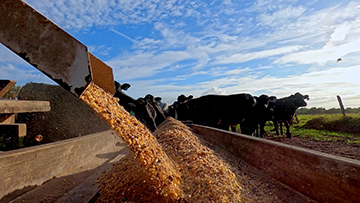Evolution of agriculture continues
Mar 04, 2024

By Terrie Ragan, ProTrition Director of Purchasing
We all deal with some sort of change almost every day of our lives — from changes in our surroundings such as the weather, to bigger changes that involve losing a loved one or a good friend that moves away. This may sound cliché, but change is most certainly inevitable. This is especially true in the field of agriculture.
In the last 25 years, we’ve witnessed the development of genetically modified crops, the implementation of technological advancements like precision agriculture, improved sustainability practices, and dramatic improvements in livestock genetics, just to name a few. All these methods have increased farming efficiency and crop yields dramatically. As the world’s population continues to grow and the number of farmers declines, it’s imperative that the agriculture industry continues to evolve to meet the needs of a changing world. Believe it or not, artificial intelligence, commonly referred to as AI, is here and will be a part of agriculture. What changes can we expect? I don’t think anyone really knows the answer to that question, but I can guarantee that it will have a huge impact on the industry.
When I think of change, I recall the book “Who Moved My Cheese.” Written by Spencer Johnson, this book is a quick read that deals with change, both in work and life, packed full of truth and insight. It encourages its readers to embrace the subject, adapt quickly, and be open to new possibilities for success in this ever-changing world. He tells us to not be afraid of new things to come. In fact, the author asks us to consider – what would you do if you weren’t afraid? In other words, don’t ever let fear hold you back.
The creation of ProTrition Feeds is another one of those agricultural milestones from the last few years that is bringing transformation to our Co-op system and the agricultural industry. This joint venture between Tennessee Farmers Cooperative (TFC) and Purina Animal Nutrition has brought leaders in animal nutrition together to better serve animal owners within ProTrition’s geography, offering producers more choices backed by the resources and history of the legacy companies.
Yes, our name has changed, but our integrity and quality standards have not. We go to great lengths to source ingredients, formulate, and manufacture the highest-quality products possible to satisfy the needs of your livestock and offer products to help you operate your livestock operations more efficiently and profitably. We may be a newly formed company, but our long-term former TFC and Purina employees are passionate and committed to serving our customers.
In closing, it’s important to recognize change and even anticipate it. The challenge is adapting to change and embracing the opportunities that it presents.
For more content like this, check out the latest issue of The Cooperator.
We all deal with some sort of change almost every day of our lives — from changes in our surroundings such as the weather, to bigger changes that involve losing a loved one or a good friend that moves away. This may sound cliché, but change is most certainly inevitable. This is especially true in the field of agriculture.
In the last 25 years, we’ve witnessed the development of genetically modified crops, the implementation of technological advancements like precision agriculture, improved sustainability practices, and dramatic improvements in livestock genetics, just to name a few. All these methods have increased farming efficiency and crop yields dramatically. As the world’s population continues to grow and the number of farmers declines, it’s imperative that the agriculture industry continues to evolve to meet the needs of a changing world. Believe it or not, artificial intelligence, commonly referred to as AI, is here and will be a part of agriculture. What changes can we expect? I don’t think anyone really knows the answer to that question, but I can guarantee that it will have a huge impact on the industry.
When I think of change, I recall the book “Who Moved My Cheese.” Written by Spencer Johnson, this book is a quick read that deals with change, both in work and life, packed full of truth and insight. It encourages its readers to embrace the subject, adapt quickly, and be open to new possibilities for success in this ever-changing world. He tells us to not be afraid of new things to come. In fact, the author asks us to consider – what would you do if you weren’t afraid? In other words, don’t ever let fear hold you back.
The creation of ProTrition Feeds is another one of those agricultural milestones from the last few years that is bringing transformation to our Co-op system and the agricultural industry. This joint venture between Tennessee Farmers Cooperative (TFC) and Purina Animal Nutrition has brought leaders in animal nutrition together to better serve animal owners within ProTrition’s geography, offering producers more choices backed by the resources and history of the legacy companies.
Yes, our name has changed, but our integrity and quality standards have not. We go to great lengths to source ingredients, formulate, and manufacture the highest-quality products possible to satisfy the needs of your livestock and offer products to help you operate your livestock operations more efficiently and profitably. We may be a newly formed company, but our long-term former TFC and Purina employees are passionate and committed to serving our customers.
In closing, it’s important to recognize change and even anticipate it. The challenge is adapting to change and embracing the opportunities that it presents.
For more content like this, check out the latest issue of The Cooperator.